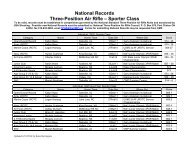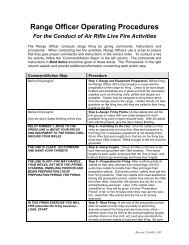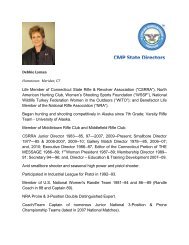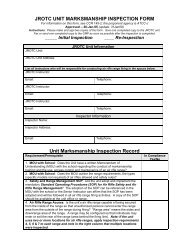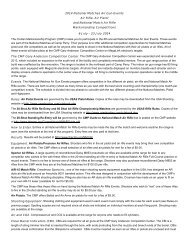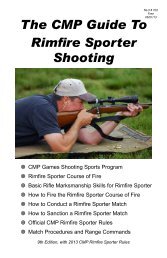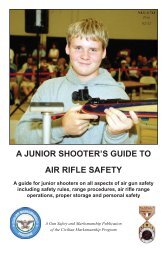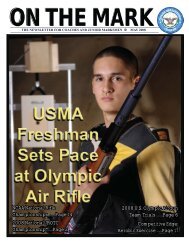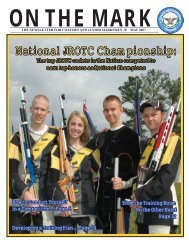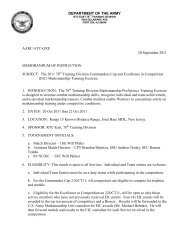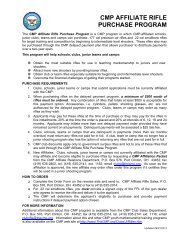FALL 2011 - Civilian Marksmanship Program
FALL 2011 - Civilian Marksmanship Program
FALL 2011 - Civilian Marksmanship Program
You also want an ePaper? Increase the reach of your titles
YUMPU automatically turns print PDFs into web optimized ePapers that Google loves.
8<br />
SIGHT ADJUSTMENT AND ZEROING<br />
5. Calling Shots and Sight Adjustment. By the<br />
time new shooters advance to three-position shooting<br />
they should be taught how to “call their shots” and<br />
correlate their shot call locations to actual shot locations.<br />
Calling a shot means taking a mental snapshot<br />
of where the sights were pointed at the precise instant<br />
when the shot was fired. Shot calls should be made<br />
before looking in a telescope for the shot locations.<br />
Shot calls should describe the direction the shot was<br />
from center by using clock face directions and should,<br />
if possible, designate the scoring ring the shot should<br />
hit.<br />
A shot that was seen as slightly low might be<br />
called as a “9 or 8 at 6 o’clock.” A high-left shot might<br />
be called an “8 or 7 at 10 o’clock.” Once a shooter<br />
becomes skilled at calling shots, this information can<br />
be used to keep the rifle zeroed and to evaluate shot<br />
technique performance.<br />
6. Spotting Scope Use. Every advanced shooter<br />
who fires on competition targets uses a spotting scope<br />
to check shot locations after each shot. By calling<br />
9 at 10 o’clock<br />
on competition target<br />
9 at 5 o’clock<br />
on BMC target<br />
This graphic illustrates two mental snapshots or shot calls made<br />
by a shooter at the instants the rifle fired together with the locations<br />
where the shooter called those shots.<br />
to use a telescope to check their shots while they are<br />
firing.<br />
One of the critical skills coaches must convey to<br />
their new shooters is the ability to analyze shot groups<br />
and adjust sights to place their shots as close as<br />
possible to the center of the target. The result will be<br />
shooters who achieve the best scores their shooting<br />
positions and shot techniques allow them to produce.<br />
shots, tracking the locations of the most recent shots<br />
in relation to shot calls and making continuing small<br />
adjustments, usually only a click or two at a time, it is<br />
possible to keep shot groups well centered throughout<br />
a course of fire.<br />
For new shooters, however, trying to use a spotting<br />
scope is more of a distraction than an aid. It is better<br />
to have them fire 5-shot groups and to check and<br />
make sight adjustments after firing the entire group.<br />
Once shooters reach the point where they are shooting<br />
three-position courses of fire, they should be ready<br />
About the Author<br />
Gary Anderson, Director of <strong>Civilian</strong><br />
<strong>Marksmanship</strong>-Emeritus, is a regular<br />
contributor to On The Mark. He served as<br />
DCM for 10 years and remains an effective<br />
advocate for<br />
firearms safety<br />
training and rifle<br />
practice. Gary’s<br />
primary role at<br />
CMP has been<br />
to develop and<br />
sustain successful<br />
youth shooting<br />
programs at both<br />
regional and<br />
national levels.




